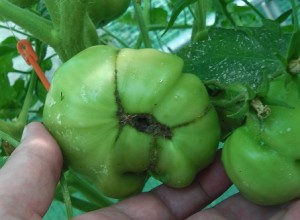Tomato flower set and other related hot weather issues.
Growing tomatoes is full of surprises …. we spend most seasons trying to find ways to avoid problems associated with poor weather, such as blight and other fungal diseases.
Now it’s finding ways to help our plants cope with hot weather and encouraging the varieties that prefer cooler conditions to set fruit.
Believe it or not, it’s too hot for growing many varieties of tomatoes!
However, it’s great to have lots of light to stimulate flower growth but problems arise when high temperatures and humidity levels prevent pollination and flowers setting fruit.
Here are some hard facts including the best temperatures for flower set.
- Optimum fruit set occurs within a very narrow night temperature range of between 60° F and 70° F that’s around 16 to 21C.
- When tomato plants experience night temperatures lower than 55° F or above 75° F that’s about 24C, interference with the growth of pollen tubes prevents normal fertilization. The pollen may even become sterile, thus causing the blossoms to drop.
- High daytime temperatures, rain, or prolonged humid conditions also hamper good fruit set.
- If the humidity is too low, the pollen will be too dry and will not adhere to the stigma.
- If the humidity is too high, the pollen will not shed readily. Pollen grains may then stick together, resulting in poor or non existent pollination.
Jack Ross, who has written a very detailed book about growing tomatoes writes on the subject of flower pollination and blossom drop:
“Experience has shown that in container culture, some varieties of tomatoes require a higher level of phosphorus than others.”
He also mentions the importance of a temperature differential between day and night to avoid blossom problems.
His book is … Hydroponic Tomato Production – a practical guide to growing tomatoes in containers.
In my garden – not all varieties respond in the same way.
For example, I’ve had excellent flower set from Sungold, but Black Cherry has been very disappointing so far this season for setting fruit. Perhaps the reason is that black varieties originated in cooler climes.
Also, Tumbling Tom and Red Alert are doing better outside than in the polytunnel because temperatures are cooler outside and there are more visitors (bees) to the flowers and often a gentle breeze.
Hot temperatures reduce the red pigment.
Very hot weather is thought to reduce yields and also reduce the red tomato pigment called lycopene – that’s why we sometimes see blotchy ripening and yellow patches on red tomatoes in hot weather.
The best temperatures for growing the majority of varieties is between 16 to 21C.
An important point to remember about growing tomatoes is that each variety is different and requires different treatment to get the very best and consistent results.
Practical tips when it’s hot
- Spray/mist with water to cool plants down in the evening.
- Pour water on ground around plants if it gets very hot to help reduce the air temperature.
- A foliar feed with a – high in phosphorus food – such as Miracle Grow once a week to help reduce blossom problems.
- Plants will be loosing a lot of moisture through their leaves so will need a lot of water. It’s best to reduce the nutrient strength when they are drinking a lot – little and often is best.
More about growing tomatoes in hot weather.
Important to read if you use milk as a foliar spray
It has been reported by Steve, one of our readers, that using a milk spray to avoid Blossom End Rot can cause an infection in the underside (blossom end) of large varieties.
Large varieties often contain cavities and scarring where milk can enter and bacteria develop – especially in hot weather.

When temperatures are high, it ‘s probably safer to avoid spraying directly on the fruit and no more than once a week. Also, reduce the milk/water ratio to 30% milk and 70% water. Using skimmed milk would also be better as it contains less fat.
Chempak Calcium is the safest option but it can be difficult to get hold of as many garden centres don’t stock it.
Your experience…
If you have experienced flower set problems and/or flower set success, it would be great to hear from you and learn which varieties struggled and which ones set easily in this hot weather in your garden.
Please leave any info. that you would like to share on this subject in the comments below – it’s always much appreciated.
Regards,
Nick
